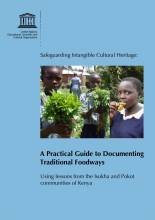In Kenya, the decline in knowledge and access to traditional foods prompted a safeguarding project with the Pokot and Isukha communities. Focusing on school students, the initiative engaged youth to inventory local food practices and knowledge using participatory methods. Primary school students, trained by teachers and local coordinators, interviewed community members to document knowledge, beliefs, practices and ceremonies linked to food production and consumption. As a result, awareness of the cultural and nutritional value of traditional foods grew and they became a symbol of cultural pride and good health. The project also spurred increased research on traditional foods in Kenya, and its methodology was replicated regionally and internationally.
© Patrick Maundu, Kenya, 2012
What was the need?
Traditional food practices in Kenya faced significant threats as external pressures linked to changing lifestyles and perspectives led to the adoption of highly commercialized, less nutritious foods, particularly among young people. Local foods were often viewed as outdated, causing them to decline in popularity. This shift jeopardized the rich diversity of local food resources, and the Indigenous knowledge once passed down by elders. The weakened transmission of traditional food culture has had consequences for food and nutrition security, biodiversity, dietary variety and community health.
‘Traditional foods are associated with less agricultural inputs, harmony with the environment, high nutritional value, dietary diversity and good nutrient balance.’
Safeguarding Intangible Cultural Heritage: a Practical Guide to Documenting Traditional Foodways
© Patrick Maundu, Kenya, 2017
What approaches were implemented?
A pilot project was launched to identify and document traditional foodways with school children, aiming to foster respect for these practices among youth. The initiative involved two primary schools in each community: Muraka and Shihuli in Isukha, and Chemolingot and Churo in Pokot. Teachers in charge of school clubs, and local coordinators were first trained in community-based inventorying techniques, including interviewing and photography. These teachers then trained students aged 12–14 to collect and document information about their communities’ foodways.
The students conducted interviews with parents and relatives, photographing traditional foods, preparation methods, and cultural practices. In Isukha, their work emphasized farming and food cultivation, while in pastoralist Pokot, documentation focused on livestock activities and wild food practices. The project explored 22 themes, including food acquisition, preparation, serving, eating, and related rituals, taboos, myths, songs and beliefs.
The inventories were complemented by a photobook, and a methodology offering step-by-step guidance for inventorying traditional foodways. The guide (see link below) covers aspects such as traditional foods types, seasonal patterns, harvesting and preparation methods, preservation methods, nutritional values and associated rituals. Each community also held a food event to raise public awareness and showcase their local foodways to the community.
This initiative, entitled ‘Success story of promoting traditional foods and safeguarding traditional foodways in Kenya’, was selected for the Register of Good Safeguarding Practices in 2021.
‘What we eat tells a lot about ourselves, our culture, our beliefs, our traditions and our ideals.’
Safeguarding Intangible Cultural Heritage: a Practical Guide to Documenting Traditional Foodways
© Patrick Maundu, Kenya, 2012
How did it work?
Public attitudes and behaviors towards traditional foods have changed for the better, with greater appreciation and transmission of traditional food practices and awareness of the threats to the diversity of traditional foodways and related knowledge about nature. Once looked down upon, traditional foods have become celebrated as a sign of cultural pride and good health. The innovative methodology of involving youth in documenting foodways has also fostered intergenerational knowledge exchange.
In addition, there was growing interest in traditional foods in the field of research and training. The number of students seeking to carry out research on local foods and seeds grew, and universities began offering courses integrating traditional food and agriculture topics.
Lastly, the manual for inventorying traditional foodways provided a model that was shared and scaled-up by other institutions at the regional level in Kenya, as well as internationally in Ethiopia and Burkina Faso. This demonstrated the scalability and impact of this approach to safeguard traditional foodways, and its ability to help address food security and diversification concerns.
© Patrick Maundu, Kenya, 2012
How was the community involved?
The communities concerned were involved in all stages of the project, via the student-led inventorying activities. The results of the inventories, including the photo book, were shared with communities upon publication, as well as during the related food events. The students often interviewed their relatives, elders and parents, building a sense of pride, belonging and cohesion in the process. Free, prior and informed consent was obtained by the different communities in local languages.
Contacts for sharing experience
National Museums of Kenya
P.O. Box 40658 00100
Language for contact: English
+254-20-8164134; +254721-308485
publicrelations@museums.or.ke
To learn more
- Video about this experience
- Book ‘Safeguarding Intangible Cultural Heritage: a Practical Guide to Documenting Traditional Foodways’

© UNESCO
Download book: English